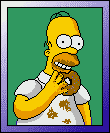 The latest news is that Dunkin’ Donuts is going trans fat free.
The latest news is that Dunkin’ Donuts is going trans fat free.
More importantly, I view it as the dipping (err, tipping) point, and an opportunity to see how we got into the trans fat mess, thanks to an article on the Harvard School of Public Health website.
It all started innocently enough when partially hydrogenated vegetable oil (trans fats) became an alternative to beef tallow.
Late 19th century
- Chemists discover they can turn vegetable oil into a solid or semi-solid by adding hydrogen atoms to the fat backbone.
- The resulting partially hydrogenated oils don’t spoil as easily as nonhydrogenated fats.
- They also withstand repeated heating without breaking down.
- Before, consumption of trans fat was limited to eating cows (or dairy products), lambs, and deer.
- By the early ’90s, trans fat intake in the United States averaged 4% to 7% of calories from fat.
1981
- Welsh researchers speculate that trans fat might be linked to heart disease.
1990s
- The public gets wind of the problem.
21st century
- The FDA estimates that approximately 95% of prepared cookies, 100% of crackers, and 80% of frozen breakfast products contained trans fat.
- Fearing lost sales, food companies begin making their products without partially hydrogenated oils, and legislatures start to outlaw them.
Now, Dunkin’ dumps trans fats.
It’s common to find “contains 0 trans fat” on food labels. Of course, that doesn’t mean there’s no trans fat. You have to know how to read the label.
8/26/07 17:19 JR